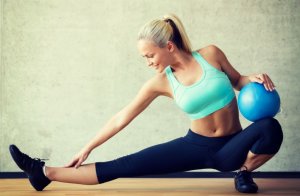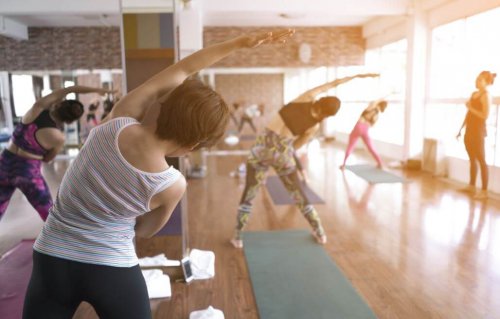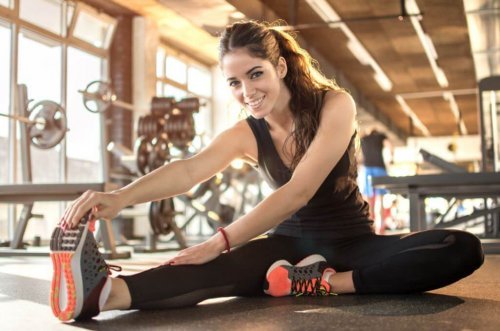Three Exercises for Improving Flexibility

Flexibility is just one of the many attributes of the human muscular system, just like strength and endurance. Many people believe that improving flexibility isn’t possible. Regardless, the truth is that improved flexibility can be achieved through some simple exercises. We will show you some of them here.
The main difference between flexibility and strength and endurance, is its regressive nature. In childhood, flexibility is at optimal levels. However, as you grow older, you will notice a considerable reduction in your flexibility.
This is a very important characteristic. And not just for people who participate in sports. If you maintain or improve your flexibility, it will have great benefits for your body.
The importance of improving flexibility
Flexibility is very important, given that it allows the body to undertake different movements and exercises. That’s why it’s important to stretch after working the muscles. These “tear” when you exercise and this exertion can fill them with tension.
On the other hand, it’s also essential to do this in order to avoid injuries. Muscular rigidity is one of the main causes of sprains and tendinitis. As such, it’s great if you can keep your muscles flexible and able to undertake complex movements.
Finally, flexibility is indispensable for maintaining your vitality. With this, your muscles stay young and are better able to withstand complex movements. This, in turn, makes them more efficient when you work out.
Exercises for improving flexibility

The preferred way to improve flexibility is through stretching. There are disciplines such as yoga that include a great variety of exercises for this. These perfect stability and body strength.
As with most physical exercises, you have to begin slowly. Afterwards, you can increase your effort gradually.
It should be noted that, if possible, it’s always better to have a teacher around when working out. That way you will avoid postural errors that could result in injuries.
There are two ways to do flexibility exercises. The first is through dynamic exercises. These are also called “bouncing exercises.” They’re simple, but you have to be careful when doing them, as they could cause injuries. On the other hand, static exercises are traditional stretching exercises.
1.- Stretching the legs

After running or working out with weights using your legs, you have to stretch your legs. A good way of doing this is through the following exercises:
- With the legs together, stretch downward, as if you were trying to touch the tips of your toes with your fingers. If you are able to do so, touch them and stay in that position for 10 to 15 seconds.
- Perform the same movement but with your legs open (shoulder-width apart).
- Stretch one leg forward from a kneeling position on the ground, as if you were thrusting it forwards. You should keep your back straight and your body turned toward the side of the forward leg. Stretch forward two or three times with each leg and keep your hands on your waist.
- While seated, stretch one leg and bend the other. Afterwards, stretch your arm towards the tips of your toes on the same side. You can also do this with both legs stretched out.
2.- Stretching the torso
Some exercises for recovering your flexibility in the torso and upper limbs are:
- In order to stretch the chest, lie face down on the floor and lift your trunk from the ground using your arms. From the abdominal area downward, the entire body should make contact with the floor. While you are doing this, stretch your elbows and look upwards.
- In order to stretch out your back, kneel on the floor and support your hands. Afterwards, extend your arms forward and bring your gluteus muscles towards your heels. You should be feeling pressure in the lumbar area.
- Sit down on the floor with one leg bent and crossed over the other, which should be extended on the floor. Afterwards, keep the stretched knee in place with the arm of the same side, in order to keep the leg firmly bent. Now you can proceed to turn your torso towards the side of the bent leg.
- Stretch your shoulders by placing your right arm over your left arm. After that, place pressure on it with the other hand. You can do this either with your arm bent at a 90 degree angle, or completely stretched out.
- You can stretch your neck by placing your right hand on your left temple and placing light pressure on it toward the right. Then, do the same for the other side.
3.- Stretching forearms and wrists
These exercises are for improving flexibility in the forearm area. They are very important to do after lifting heavy weights. Through these, you can eliminate the tension that’s created in these muscle groups. You will also help to avoid any injuries due to excessive weight.
- Stretch one of your arms out with the palm of your hand facing the front, and your fingers facing downward. With the other hand, put pressure on the fingers, pulling them backwards.
- A variant of the previous exercise is to perform the same movement, but with your fingers pointing upwards.
- Support the palms of your inverted hands while kneeling on the floor. That is, with the fingers pointed towards your knees. Slowly bend your body forwards, until you feel your forearms and wrists gently stretching.
Maintaining good flexibility is so important. It becomes even more important as the years go by. This is because you can gradually start to lose flexibility with age. By performing these simple exercises three to five times per week, you can improve your flexibility and your well-being.
Flexibility is just one of the many attributes of the human muscular system, just like strength and endurance. Many people believe that improving flexibility isn’t possible. Regardless, the truth is that improved flexibility can be achieved through some simple exercises. We will show you some of them here.
The main difference between flexibility and strength and endurance, is its regressive nature. In childhood, flexibility is at optimal levels. However, as you grow older, you will notice a considerable reduction in your flexibility.
This is a very important characteristic. And not just for people who participate in sports. If you maintain or improve your flexibility, it will have great benefits for your body.
The importance of improving flexibility
Flexibility is very important, given that it allows the body to undertake different movements and exercises. That’s why it’s important to stretch after working the muscles. These “tear” when you exercise and this exertion can fill them with tension.
On the other hand, it’s also essential to do this in order to avoid injuries. Muscular rigidity is one of the main causes of sprains and tendinitis. As such, it’s great if you can keep your muscles flexible and able to undertake complex movements.
Finally, flexibility is indispensable for maintaining your vitality. With this, your muscles stay young and are better able to withstand complex movements. This, in turn, makes them more efficient when you work out.
Exercises for improving flexibility

The preferred way to improve flexibility is through stretching. There are disciplines such as yoga that include a great variety of exercises for this. These perfect stability and body strength.
As with most physical exercises, you have to begin slowly. Afterwards, you can increase your effort gradually.
It should be noted that, if possible, it’s always better to have a teacher around when working out. That way you will avoid postural errors that could result in injuries.
There are two ways to do flexibility exercises. The first is through dynamic exercises. These are also called “bouncing exercises.” They’re simple, but you have to be careful when doing them, as they could cause injuries. On the other hand, static exercises are traditional stretching exercises.
1.- Stretching the legs

After running or working out with weights using your legs, you have to stretch your legs. A good way of doing this is through the following exercises:
- With the legs together, stretch downward, as if you were trying to touch the tips of your toes with your fingers. If you are able to do so, touch them and stay in that position for 10 to 15 seconds.
- Perform the same movement but with your legs open (shoulder-width apart).
- Stretch one leg forward from a kneeling position on the ground, as if you were thrusting it forwards. You should keep your back straight and your body turned toward the side of the forward leg. Stretch forward two or three times with each leg and keep your hands on your waist.
- While seated, stretch one leg and bend the other. Afterwards, stretch your arm towards the tips of your toes on the same side. You can also do this with both legs stretched out.
2.- Stretching the torso
Some exercises for recovering your flexibility in the torso and upper limbs are:
- In order to stretch the chest, lie face down on the floor and lift your trunk from the ground using your arms. From the abdominal area downward, the entire body should make contact with the floor. While you are doing this, stretch your elbows and look upwards.
- In order to stretch out your back, kneel on the floor and support your hands. Afterwards, extend your arms forward and bring your gluteus muscles towards your heels. You should be feeling pressure in the lumbar area.
- Sit down on the floor with one leg bent and crossed over the other, which should be extended on the floor. Afterwards, keep the stretched knee in place with the arm of the same side, in order to keep the leg firmly bent. Now you can proceed to turn your torso towards the side of the bent leg.
- Stretch your shoulders by placing your right arm over your left arm. After that, place pressure on it with the other hand. You can do this either with your arm bent at a 90 degree angle, or completely stretched out.
- You can stretch your neck by placing your right hand on your left temple and placing light pressure on it toward the right. Then, do the same for the other side.
3.- Stretching forearms and wrists
These exercises are for improving flexibility in the forearm area. They are very important to do after lifting heavy weights. Through these, you can eliminate the tension that’s created in these muscle groups. You will also help to avoid any injuries due to excessive weight.
- Stretch one of your arms out with the palm of your hand facing the front, and your fingers facing downward. With the other hand, put pressure on the fingers, pulling them backwards.
- A variant of the previous exercise is to perform the same movement, but with your fingers pointing upwards.
- Support the palms of your inverted hands while kneeling on the floor. That is, with the fingers pointed towards your knees. Slowly bend your body forwards, until you feel your forearms and wrists gently stretching.
Maintaining good flexibility is so important. It becomes even more important as the years go by. This is because you can gradually start to lose flexibility with age. By performing these simple exercises three to five times per week, you can improve your flexibility and your well-being.
This text is provided for informational purposes only and does not replace consultation with a professional. If in doubt, consult your specialist.








